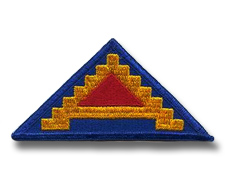If you do
NOT see the Table of Contents frame to the left of this page, then
Click here to open 'USArmyGermany'
frameset |
12th
Antiaircraft Artillery Group
34th AAA Brigade
Looking for more information from military/civilian
personnel assigned to or associated with the U.S. Army
in Germany from 1945 to 1989. If you have any
stories or thoughts on the subject, please contact me . .
|
|
|
|
|
| |
| History |
| |
| |
| |
| 1950
- 19.. |
The 12th
AAA (AW) Group arrved in Bremerhaven on Nov 25 1950.
The Group was stationed at Gerszewski Bks, Karlsruhe, from Nov 26,
1950 to at least Mar 3 1953. On June 1 1951, the Group was assigned
to the 34th AAA Bde. |
|
| |
| (Source: HISTORICAL
HIGHLIGHTS OF THE NEW MEXICO NATIONAL GUARD) |
The Korean Conflict
caused the Federal activation of several units from New Mexico. Along
with the three AAA units, the 717th AAA Gun Battalion
was called to Federal Active Duty. The Bn was first ordered to Fort
Bliss, Texas; it remained there until March of 1952, when it was ordered
overseas to become a part of the 12th AAA Group
at Karlsruhe, Germany.
This unit was returned to the United States on 1 March 1953. (NOTE:
I believe that the 717th was replaced by the 25th AAA Bn. Information
on units history of the 25th indicates that the 25th AAA Battalion
was reactivated at Karlsruhe, Germany in 1953 and organized, first
as a gun battalion and then as a missile battalion (in 1957). The
25th AAA Battalion was inactivated in Germany on 1 September 1958.)
NOTE: In the last few months of 1952 and first few of 1953,
federalized NG AAA battalions were demobilized for return to the control
of their respective states. Simultaneously new active army battalions
were activated to replace the demobilizing units. Since most of the
federalized guard units had long been filled with draftees, the actual
effect was merely a change of designation. Equipment and personnel
remained.
ADDITIONAL INFORMATION
Found confirmation in a brief article in the STARS & STRIPES (Feb 25, 1953): The 25th AAA Gun Bn was activated at Gerszewski Barracks, Karlsruhe, to replace the 717th AAA Gun Bn, 12th AAA Gp. The colors of the 717th are being returned to the States. CO of the newly activated 25th is Lt Col John L. Bates. |
 |
|
|
| 73rd AAA AW Battalion (SP) |
| |
 73rd AAA AW Bn (SP) DUI 73rd AAA AW Bn (SP) DUI |
| |
| (Source: Email from John Merna, Hq/Hq Btry, 73rd AAA Bn) |
 Hq/Hq Btry, 73rd AAA Bn
Hq/Hq Btry, 73rd AAA Bn
|
|
In Sept. 1955, I was assigned to the 73rd AAA after leaving the States on the troop ship Harry Taylor and off loading in Bremerhaven. We were put on a train to ZWEIBRUECKEN and there I was assigned to the 73rd at Gerszewski Barracks outside of Karlsrure. The battalion was part of the 12th AAA Gp and we wore the 7th Army Patch.
Do you have any other contacts? I know of two -- Hartlet and Winship. |
|
|
 |
|
| |
| 91st
AAA AW Battalion (Mbl) |
| |
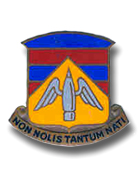 91st AAA Gun Bn DUI
91st AAA Gun Bn DUI |
| |
 91st AAA Bn Pocket Patch
91st AAA Bn Pocket Patch
|
|
|
|
|
| |
| 1952 |
| (Source: 91st AAA AW Bn (M), First Anniversary, 91st AAA Bn PIO, 1952) |
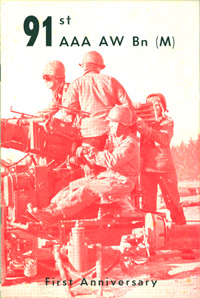 91st AAA Bn 1st Anniversary
91st AAA Bn 1st Anniversary
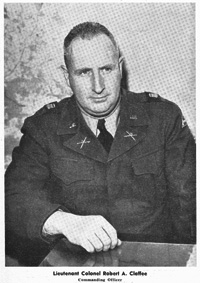
Lt Col Robert A. Claffee
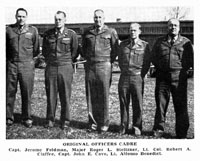
Officer Cadre
|
|
Proud Past -- Bright Future |
| |
On June 25, 1950, three days after the outbreak of the Korean conflict, the 413th Antiaircraft Artillery Gun Battalion was redesignated the 91st Antiaircraft Artillery Automatic Weapons Battalion (Mobile) and plans were begun for the reactivation of the unit. Allotted to the regular army and assigned to the European Command on 16 February 1951, the 91st was reactivated in Karlsruhe, Germany, on the First of April in the same year. The battalion, attached to Seventh Army, was placed under the 12th AAA Group. Lt Col Robert A. Claffee was appointed commanding officer, and a cadre of officers and noncoms was assigned to the newly activated organization primarily from other antiaircraft snits in the command.
The battalion moved to its present home station of Flak Kaserne in Ludwigsburg after a two month organization period in Karlsruhe. At that time, though under strength, a training schedule was inaugurated. In mid-July Headquarters Battery successfully participated in the 34th Brigade Exercise Blue Sky, the first field exercise for the young battalion.
At the close of summer an influx of "casuals" from basic training camps in the States brought the unit to proper strength. The 91st then proceeded to train these men, who had had no training on AAA Automatic Weapons, the many varied and intricate processes that are involved in the effective and efficient operation of an antiaircraft battalion. The members of the battalion filled each day with hard work in the concentrated effort to prepare as rapidly as possible for any eventualities.
The arduous task of preparing the 91st for the firing line culminated in November when the battalion moved to Grafenwoehr for familiarization fire. The novice 40mm and M55 gun crews showed an adeptness for knocking down both radio controlled air targets and airplane towed sleeves. While at Grafenwoehr, the men also qualified on the various small weapons organic to the unit.
After the two week stay at Grafenwoehr, the battalion returned to Ludwigsburg to continue its stringent training. The months December, January, and February were spent participating in countless tracking missions, innumerable field problems, and many hours of classroom work. Strict maintenance was observed; the staff officers held a Command Maintenance Inspection for each battery every five weeks. As a result of this preparedness, the battalion received an excellent rating on the Seventh Army CMI in December.
On February 28 the battalion returned to the Grafenwoehr firing range to shoot for record. The long and tedious hours of training in garrison produced a very high score on the part of the now skillful gun crews. In addition to puncturing many holes in the sleeve targets, the sharpshooting gunners knocked down five R-Cats with 40mm shells to augment their firing trials. Previous to this, only seven R-Cats had been lost to 40mm fire by the 49th R-Cat Detachment in EUCOM.
Upon successfully completing the record fire, the unit moved to Mainz for further field training, concentrating on infantry squad tactical exercises and the tracking of high speed low flying aircraft. On March 23 the battalion returned to Ludwigsburg to prepare for the First Anniversary festivities on April 1.
The first year of the reactivated 91st AAA AW Bn (M) has been a busy one. 8y the great effort put forth by all the members of the organization, the unit has grown from infancy to a strong, well trained antiaircraft battalion ready to do a job -- a good job -- if the need should arise. |
|
|
| |
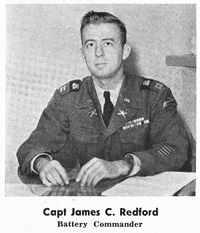
Capt. James C. Redford
|
|
Headquarters Battery |
| |
Headquarters Battery was born on 1 April 1951 in Karlsruhe. At that time Battalion Headquarters was little more than a few borrowed rooms furnished with packing boxes for desks, and smaller wooden crates for chairs. Yet from this inconspicuous beginning has arisen the smoothly functioning unit of today.
Headquarters Battery was guided through its tender months by Capt Jerome Feldman, then battery commander, WOJG Jack C. Holman, and M/Sgt Melvin Miller. Those were the days of hard work, broken by occasional softball games during off hours. Capt Feldman proved himself a solid man in the outfield and was only once sidelined by an injury to his officer's pinks which were shredded by a terrific slide across home plate. As always, Has Btry had good bench strength, and "Babe" Warhaftig filled in ably for the rest of the game.
In June the 91st moved to Flak Kaserne, joining the "terrible hundred" who had been assigned, but not joined, from the 62nd AAA. From these men, and other new arrivals who trickled in during the summer, a well organized battery was formed and the various sections necessary to the administration of the Battalion swung into operation. |
|
|
The S-1 (administration) Section was then handled by Sfc Ben Jones, now commo chief of Hqs Btry, and Cpl Robert Weeks. The personnel sergeant was Sgf Brand, now retired. Battalion supply was handled by Sgt DeMarco and Sgt Panich. Sgt Hall took care of the Battalion Communications. Sgt Basil supervised the Battalion Maintenance section. M/Sgt Gilmartin was Operations Sergeant, and Sgt Almon Johnson the Intelligence Sergeant. The Battery and Battalion are indebted to this pioneer cadre for the present proud position.
On June 15 Capt Feldman was moved up to Battalion Mess Officer, and Captain Allen B. Moore became B. C. Reserved, efficient, and well liked by all, Capt Moore was Battery Commander until October when he was promoted to the position of Adjutant. Captain James C. Redford assumed command of the battery, and fills that position at this time.
A number of high spots stand out as one looks back over the yearling Battery. The move from Karlsruhe, the summer softball games always postponed because of rain, the influx of men in September, the Sunday 4AM alerts, Jim Murray the first Draftee to make sergeant, Grafenwoehr once and Grafenwoehr again. It has been a year in which the battery has grown from nothing to something, to something which every man can be proud -- proud that he is a soldier of Hq Battery, 91st AAA AW Bn (M). |
| |
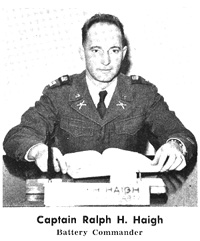
Capt. Ralph H. Haigh
|
|
"A" Battery |
| |
Under the supervision of WOJG Jack C. West, "A" Battery, with a small cadre, began the tremendous task of organizing the unit into functional order on 1 April 1951. On May 4, 1st Lt Richard S. Jones joined the battery as commanding officer. With the aid of such key noncoms as M/Sgt Wilber L. Margan (now WOJG), cadre training was started and the men responded splendidly. With slightly more than forty men in the battery of the time of the move to Ludwigsburg, strict maintenance of the weapons, vehicles, and other equipment kept everyone extremely busy. On June 28 the very able Captain Ralph H. Haigh took command of the battery, which had now grown to approximately seventy men in strength. Subsequently more men were assigned to the battery, and also three more officers, 1st Lts Ramon U. Ensminger, Harry W, Hensel, and 2nd Lt Lawrence Trachy.
Several members of the battery received commendations for high standings in their class of various service schools. Sergeants Einar Larson, John Niermann, Cpl Louis Feazel, and Pfc Arthur Mullin for outstanding records at the Artillery School. Sfc Albert Bernier received a high rating at Mess Steward's School.
Lt Col Claffee awarded Capt Haigh the "Best Battery" award at Retreat
Ceremonies on 31 January 1952. The honor was based on the several phases of battery training, Command Maintenance Inspection scores, personal conduct ratings, and the general efficiency of the battery.
Gun crews from "Able" Battery were credited with the destruction of several Radio Controlled Air Targets during the firing for record al Grafenwoehr in March. This fine shooting is indicative of the progress and status of training of the unit in this first year.. |
|
|
| |
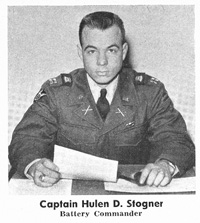
Capt. Hulen D. Stogner
|
|
"B" Battery |
| |
The assignment of M/Sgt Denton Reichwein to Battery "B" in Karlsruhe, Germany, on 1 April 1951 marked the start of this battery in the infant 91st Battalion. Commanding the battery during the early stage of its development was James C. Redford, who at that time held the grade of First Lieutenant. WOJG Norman H. Fournier has been the battery administrative officer since its beginning one year ago. In June Lt Redford was hospitalized due to a mishap which occurred while supervising battery training in the gun park. During his stay in the hospital, he was promoted to captain and assigned B. C. of Headquarters Battery. As replacement for the ailing battery commander, Captain Hulen D. Stogner joined the battery on 27 June 1951 as commanding officer. 1st Lt Joseph L. Hogan came to the unit in July as executive officer. During the course of the year Lt Thomas N. Richmond, battery officer, returned to the ZI and Lt Christopher B. Martin arrived from Stateside to take his place on November 29. Lt Wayland W. Rennie, another arrival from the US, came to the battery in August. Lts Rennie and Martin were promoted from second to first lieutenants while serving with the battery this year. Lt Darius P. Galipeau, though attached to Battery "B", is now working in the capacity of Battalion Mess Officer.
Starting from "scratch" gave the few men who were assigned to the battery during the first months an opportunity to earn positions of leadership and responsibility. The original cadre of noncoms from the 48th AAA Battalion was supplemented by a small group of men -- all privates -- from the 62nd AAA Battalion. Aside from innumerable promotions to the grade of Pfc and Corporal, nine men were elevated to Sergeant. The list of new first three graders includes Frank A. Tiseo, Neil J. Schildwaster, Thomas P. Preston, Sampson Lilley, John Northup, Joseph Kwiatkowski, Edward E. Fitzpatrick, Leo Kaliszewski, and Alfred B. Borowsky. Of these men, five were privates when they entered the battery. |
|
|
The building of the battery to a highly efficient, well organized antiaircraft firing unit has meant a lot of long, hard working hours on the part of everyone in the battery. But looking at the job accomplished in the first year proved that it was well worth the effort. The spirit of the battery can be depicted by the statement of Sgt Kalizsewski when he returned from a Stateside furlough and said. "It's great to be back homel" meaning back home with "Baker" Battery.
The battery moved to a slow start in sports. The close of the battalion softball season found Battery "B" in the cellar. Considerable improvement was noted during the Touch Football League games, and the "Baker" team placed second, losing only to the league champs from Battery "C". Moving undefeated through the Battalion Basketball league, the champion "B" quint went to the 12th AAA Group finals, representing the 91st, but missed the Group championship by a scant three points in a thrilling game with the 73rd AAA AW Bn. A "new look" in "Baker" Battery sports, which has had its origin on the basketball court, will be prevalent throughout the coming year.
The first year has been a happy and successful one. Battery "B" stands ready to undertake its duties in the battalion and in the defense of Europe in any way it may be necessary. |
| |
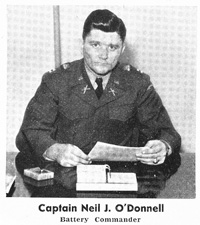
Capt. Neil J. O'Donnell
|
|
"C" Battery |
| |
Many trophies, plaques, and awards can be seen in the "Charlie" Battery dayroom. Also many individuals have proven their skill. All through the year the men have worked as a team, sometimes 'til the wee hours of the morning, in order to place first in sports, inspections, and firing.
In the summer of 1951, with just a few men in the battery, the Battalion Softball Trophy was captured. Early in the foolball season the Battery "C" team took the lead and rolled on to win the Battalion Touch Football Trophy. The championship team was comprised of Cpl's Pietrzyk, Liederbach, Ricciardelli, Cortright, and Sikora, Pfc's Clofl, Harant, Gillen, and Steenbergh, Pvt Aiani, and M/Sgt Roche. In December's Physical Fitness Test Cpl Cortright and Pfc Sharp proved their strength by obtaining the highest scores in the battalion. A plaque was awarded Cpl Cortright for turning in the highest score, 470, and Pfc Sharp's 463 was a very close second.
While the men were winning in sports, they were also doing their best for inspections. The hours spent cleaning equipment and pulling maintenance were not in vain. For their reward, in the third quarter the battery won the "Best Battery" plaque, and placed second in the fourth quarter. |
|
|
Battery "C" has also excelled on the firing ranges at Grafenwoehr. In November the battery scored the highest average in the Battalion on the carbine range. Cpl Phillips obtained the battalion's highest individual score of 196. During the second stay of Grafenwoehr in March, the 40 mm and M55 crews competed against the other batteries for highest score. Final results showed "Charlie" Battery was again the Champ.
The members of the battery have their good times, but they are also planning for the future. In Soldier's Deposits "Charlie"
Battery was first in the battalion eight months out of ten, and one month attained an average of 100%.
With the accomplishments of the first year as a guide, Battery "C" plans to do a much greater job as it enters its second year. |
| |
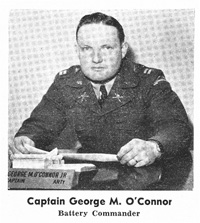
Capt. George M. O'Connor
|
|
"D" Battery |
| |
With Captain Richard R. Calder at the helm, Lieutenant Edwin M. Caldwell as battery executive officer, and a cadre of fifty men from the 48th and 62nd AAA Battalions, Battery "D" came to life at Gerszewski Barracks in Karlsruhe one year ago. This small nucleus of a battery, with room and board supplied by the 552nd AAA Gun Battalion, proceeded to round the second hand equipment donated to the battery into top notch shape. This meant hard work all the time -- but how many men could two officers watch at one time?
On 8 June 1951 the battery made its exodus to Flak Kaserne in Ludwigsburg. At last it was realized that the army had not forgotten the 91st and Battery "D". No more poaching with the "five, five, deuce". Now the battery occupied its own billets and all that goes with a "home of your own".
Captain Calder was rotated back to the Stales on July 9th, and the present battery commander, Captain George M. O'Connor took over the reins. More "brass" was added on July 24 when four second lieutenants with that infamous "if you don't I'll pull your pass" look in their eyes reported for duty. The quartette was comprised of Lieutenants Spielman, Spadone. Neuville, and Jackmond.
After the move to the FIak, training schedules began to pour down from battalion headquarters in torrents. The picnic was over. From the dawn trot around the kaserne to the retreat ceremonies at dusk, the battery was kept on the go. Checking headspace and timing at 0100 hours was not uncommon. There was plenty of headspace; the timing was the thing that caused the insomnia. |
|
|
"D" Battery moved into high gear in October with the arrival of "new blood" -- enough to bring the b attery up to strength -- from Stateside. Top honors were won in the second round of the Battalion CMI series, and the perennial rivals from "Charlie" won the first quarter trophy by only a nose because Battery "D" had a slow start. The 91st "Dark Horse" was beginning to make its presence felt!
Two master sergeants, Scruggs and Tafton, left the battery in January to return to the States. But able replacements were found in "Curly" Fitzpatrick and "Lit Abner" Capps. The battery also received a big lift with the arrival of WOJG Morgan as administrative officer.
After a series of victorious skirmishes with Echterdingen's Prize Field Mice, the battery joined with Battery "C" in a short journey back to Gerszewski in Karlsruhe in February. This time borrowed quarters were not needed as garage accommodations with centrally located hydraulic lifts were generously furnished.
Surviving successfully the March expedition to Grafenwoehr and Mainz, Battery "D" enjoyed a breather back at FIak Kaserne, with its new library, snack bar, service club, and gymnasium, to round out year one.
The battery enters info its second year confidently ready for come what may. |
| |
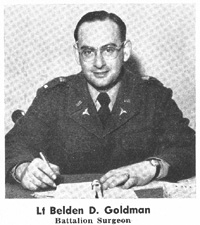
Lt. Belden D. Goldman
|
|
Medical Detachment |
| |
The Medical Detachment was activated 7 May 1951 of Karlsruhe, Germany, with four enlisted men being assigned for duty. These men were Sfc W. Voltz, Sgt E. Heinsen, Sgt E. Turner, and Cpl L. Welke. In June when the Battalion moved to Flak Kaserne, a dispensary was established. Lt Paul Lee, medical officer, reported for duty as commanding officer of the detachment in August and was responsible for much of the training of the Medics personnel and the organization of a complete aid station. Seven men joined the detachment in August to fill the "TO" vacancies. In December Lt Lee was transferred, and Lt Edward Frank, MC, joined the detachment for a short time. Later in the month Lt Belden D. Goldman replaced Lt Frank and has served as Battalion Surgeon since that time.
It has been the aim of this detachment to provide the best medical care possible for the members of the Battalion. In order to do this, the emn have cooperated in our training program and unit duties and are ready at all times to serve.
|
|
|
 |
|
| |
| (Source: Email
from Ron Schloss) |
I served in the
91st AAA Bn (Towed) during the period
July 1951 - Jan 1953. I was originally assigned as a radio operator
to the 2nd Platoon of Battery "C" after completing a course at the
EUCOM Signal School at Ansbach, Germany. However, the there was no
position open for me. I went to see the Bn Personnal Officer and when
he learned I could type, I was immediately transferred to "HQ" Battery
and became the Officer's Records Clerk, where I remained until I rotated
home. I also was the Driver for the Personnal Section.
Ron Schloss |
| |
91st
AAA AW Bn (Mbl)
Flak Ksn, Ludwigsburg |
|
The
following are pictures that Ron submitted, taken in and around
the Flak Kaserne or on maneuvers.
|
|
|
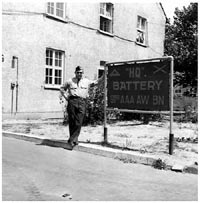
1.
Ron next to HQ Bty sign
|
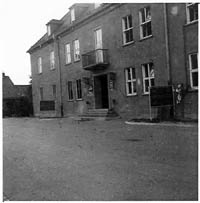
2. 91st
AAA Bn headquarters
|
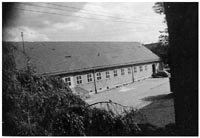
3. Mess hall
|
|
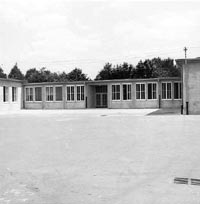
4. Service club
|
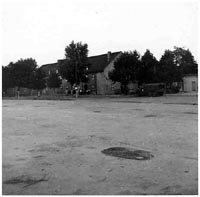
5.
HQ Btry barracks
|
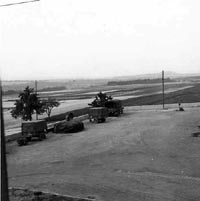
6. View
from barracks window
|
|
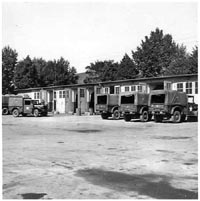
7.
Vehicles in front of a maintenance shop |
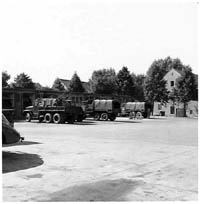
8. Vehicles
of a firing battery |
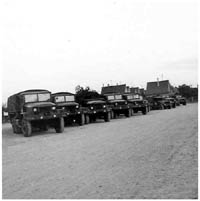
9. HQ Btry motor pool
|
|
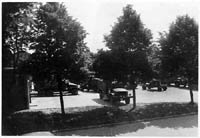
10. Vehicle shop area
|
|
|
|
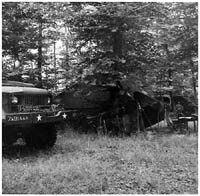
11.
HQ Btry during maneuvers
|
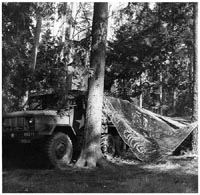
12. Ron's
truck under camo netting
|
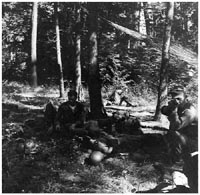
13. Taking a break
|
|
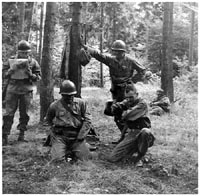
14. Relaxing during a break |
|
|
|
|
|
| |
|
This
pictures are from the webmaster's collection
|
|
|
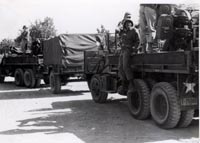
1.
Truck-mounted quad .50 caliber machineguns
|
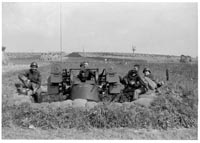
2. Looking
for enemy aircraft
|
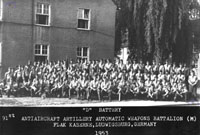
3. Group photo, "D" Btry, 1953 (220 KB)
|
|
|
|
|
| 183rd Ordnance Detachment (IFCR T-38) |
| |
| (Source: Email from Ben Hudson) |
| Following are some notes that I have put together regarding my experience with the 183rd in Germany during the period 1955-1956. It has been 55 years since I left the unit to return to the Sstates so I may not recall the details as sharply as I once could but I believe they are accurate.
183rd Ordnance Detachment (IFCR T-38) - Skysweeper
Rhine Kaserne, Biebrich, Germany, Feb 1955 - Jul 1956 I served with the 183rd Ordnance Detachment (IFCR T-38) at Rhine Kaserne in Biebrich (a suburb of Wiesbaden), Germany, from February of 1955 through July of 1956.
I believe the 183rd was newly formed in 1954 when I was assigned to it. We were training as electronics technicians for support of the T-38 (Skysweeper) 75mm anti-aircraft system at Aberdeen Proving Grounds, Maryland, when we were selected to serve with specific units to be deployed around the world. We interviewed with warrant officers that were to serve as commanding officers of these units and those warrant officers selected their own teams of technicians to serve under them.
Our unit at that time included: (1) a warrant officer as commanding officer; (2) 6 technicians to repair the radar, computer and other fire control components of the system; and (3) a supply clerk to maintain the rather extensive inventory of parts that would be required in the repair process - for a total of 8 persons. I believe that was the standard organization for all the IFCR T-38 ordnance detachments. After selection we entered a unit training program (still at Aberdeen) where we continued to train for the T-38 system, but as a designated unit. My rank was SPEC-3 (E-3) at that time. In February of 1955 we were assigned to support the 91st Anti-Aircraft Battalion at the Rhine Kaserne in Biebrich, Germany. We shipped over on a Military Sea Transport System troop ship, William O. Darby, arriving at Bremerhaven after 9 days at sea. We traveled to Wiesbaden by train. The kaserne occupied basically a city block in Biebrich. The 18 Skysweeper units were kept at a gun park several miles east of the kaserne. Our large, 4 story barracks building (which housed both the battalion and the ordnance detachment) looked directly down across the levee to the Rhine River. The Wiesbaden area was a delightful place in which to serve.
There was another T-38 IFCR ordnance detachment located in Wiesbaden proper, having arrived, as I recall, just a few months before we did. It serviced another anti-aircraft battalion - I don’t recall the numerical designation of either the ordnance detachment or the battalion. (Webmaster note: according to the STATION LIST for Aug 1955, there probably were two additional T-38 ICFR units in Wiesbaden at the time -- the 223rd Ordnance Detachment and the 371st Ord Det. There were also two additional 75mm AAA (Mbl) battalions located in Wiesbaden -- the 5th and 443rd AAA Bns.) The T-38 Skysweeper system was a 75 mm anti-aircraft weapon with on carriage radar and computer systems. Each battalion had 18 of these units. It was highly mobile and was designed to defend airbases against high speed, low flying aircraft, in particular, at that time, the Russian MIG. The aircraft that we most commonly saw in training and maneuvers was the American F-86 Sabre Jet. In addition to routine, day-to-day maintenance and repair activities at the home base, other activities of the detachment included:
  Periodic deployments on maneuvers with the anti-aircraft battalion, often involving NATO allies. Typically these were for the battalion to defend airbases in surrounding areas of Germany. Two locations pop into my mind but my memory may not be serving me well in these regards. The two are Spangdahlem and Bitburg. Periodic deployments on maneuvers with the anti-aircraft battalion, often involving NATO allies. Typically these were for the battalion to defend airbases in surrounding areas of Germany. Two locations pop into my mind but my memory may not be serving me well in these regards. The two are Spangdahlem and Bitburg.   Periodic deployments to a British firing range on the German Baltic shore near the little village of Todendorf. There the battalion weapons were fired at target sleeves towed by aircraft and drones using full fire control system capabilities. There were always plenty of repair and maintenance issues with the radar and other systems to keep our detachment very busy. Periodic deployments to a British firing range on the German Baltic shore near the little village of Todendorf. There the battalion weapons were fired at target sleeves towed by aircraft and drones using full fire control system capabilities. There were always plenty of repair and maintenance issues with the radar and other systems to keep our detachment very busy.
  Occasionally the battalion would transport its anti-aircraft weapon systems to a firing range at Grafenwoehr to manually fire the weapons without using the radar or computer systems. Our detachment would send one shop truck and 2 or 3 technicians with the battalion in case issues arose with the hydraulic slewing mechanisms (parts of which we also serviced). I believe that Grafenwoehr was primarily a tank firing range. Occasionally the battalion would transport its anti-aircraft weapon systems to a firing range at Grafenwoehr to manually fire the weapons without using the radar or computer systems. Our detachment would send one shop truck and 2 or 3 technicians with the battalion in case issues arose with the hydraulic slewing mechanisms (parts of which we also serviced). I believe that Grafenwoehr was primarily a tank firing range.
I don’t recall any details of the organizational relationships of our detachment with higher levels of Army units. The 183rd detachment was attached to the 91st anti-aircraft battalion for billets, mess and to provide maintenance and repair for its Skysweeper units. Otherwise it operated fairly independently of the battalion. Wiesbaden was primarily an Air Force area and, interestingly, we were paid by the Air Force. Pay was in the form of military scrip (looked like monopoly money) and, in the mid-1950’s, it was illegal to use American greenbacks on the German economy. You could exchange the scrip for deutschmarks at the American Express office in town and spend those on the German economy.
At the beginning of my tour, we were still considered an Army of Occupation and occupied Germany was still divided into American, British, French and Russian sectors at that time. Wiesbaden was in the American sector and right on the border with the French sector. The contrast regarding progress in recovery from the war was stark. At that time, ten years after the end of World War II, the American sector of Germany had recovered to an astonishing degree. Wiesbaden, which had not been bombed very much, was an incredibly beautiful city and thriving. Just upstream on the other side of the Rhine River from our barracks was the city of Mainz, in the French sector. Mainz was still mostly a plain of rubble from the bombing with very little recovery evident. The French, as one might expect, had not invested a dime in the reconstruction of its sector of Germany.
While I was in Germany with the 183rd Ordnance Detachment in 1955-1956, for those uniforms for which a left shoulder patch was worn, it was the triangular Seventh Army patch, referred to informally as the "seven steps to hell". To the best of my recollection, both the anti-aircraft battalion personnel and the ordnance detachment personnel wore that same shoulder patch.
My tour of duty with the Army in Wiesbaden was a terrific experience and I would not have missed it for anything. It has been gratifying to reflect back on that experience. I kept in touch with a few of the guys for a time after I got out in 1956, but I am no longer in touch with any of them. I have tried from time to time to see if I could locate any of them on the internet, but without success. I am now 76 and it is entirely possible that some of them are no longer with us. Although I went into the Army at 18 in 1953, right out of high school, several of them had graduated from college (the draft was still on in those days) and, hence, were several years older than I. Although the original team had 8 members, those numbers sometimes increased by one or two, perhaps in anticipation of someone rotating out. I have forgotten the names of some of the team members. The commanding officer was CWO “Bud” Thoenen. The supply clerk was Ken Entfield (or, perhaps Entfeld). The original technicians that I can recall, in addition to myself, were Roger Felker, Marshall Coburn and Larry Tyree. Some who joined us later were Richard Szostak, Denny Schroeder, and Ross and Joseph Cassella (twins!). Another, Bart Spears, I can’t remember if he was one of the originals or a later addition. I left the unit with the rank of SPEC-5 (E-5). I hope this has not had too much extraneous personal stuff in it. If you have any questions about any of it I would be happy to try to respond. If you have received any information regarding any of the people mentioned above or the detachment itself I would appreciate hearing about it so that I might try to get in contact with them. |
 |
|
| |
| 552nd AAA Battalion (Gun 90mm) |
| |

552nd AAA Bn demonstrates its equipment during an Open House, 1955 (Webmaster's collection) |
| |
| 1950s |
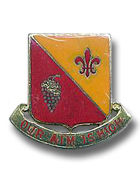 552nd AAA Gun Bn DUI 552nd AAA Gun Bn DUI |
| |
| (Source: Email from Girard "Pete" Scheetz) |
I have searched the Internet for the past 5 years and can't find a thing regarding my outfit. I'm looking for anything regarding the 552nd Antiaircraft Artillery Gun Battalion (90mm) stationed at Gerszewski Barracks, Karlsruhe, Germany.
When I arrived there in July 1950, we were assigned to the Constabulary and attached to the 1st Infantry Division and wore their patch (The Big Red 1).
I think that shortly thereafter we were made part of the 12th Group. I know for sure that we were in the 7th Army (Seven Steps To Hell).
I rotated home in July, 1953 and lost track of my outfit and often wondered what happened to them.
|
|
|
|
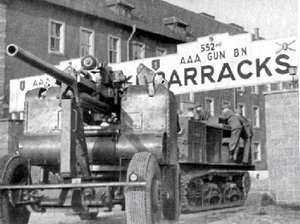
1. A CAT with a 90mm gun in tow enters the main gate at Gerszewski Barracks
|
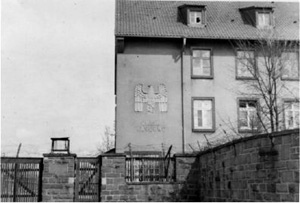
2. Symbols of the previous occupants of Gerszewski are still visible in 1950
|
|
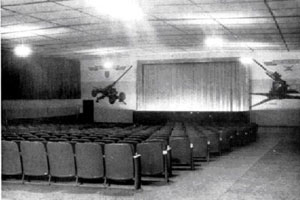
3. Inside the Post Theater
|
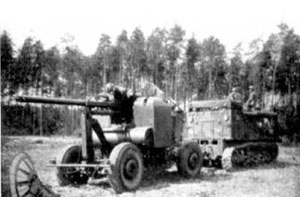
4. Elements of the 552nd in the field
|
|
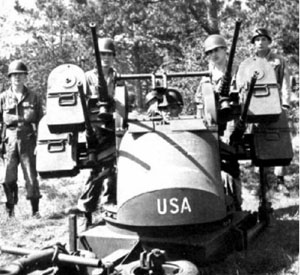
5. A Quad-50 provides support during a field exercise
|
|
|
|
|
| |
| HISTORY (552nd AAA Gun Bn) |
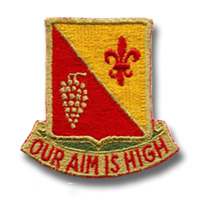 552nd AAA Bn Pocket Patch
552nd AAA Bn Pocket Patch
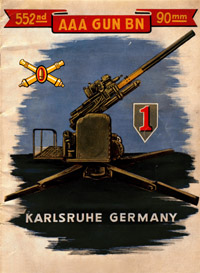
|
|
On the day of its activation, 22 November 1948, the 552d Antiaircraft Artillery Gun Battalion was confronted with more than the ordinary succession of problems which face a newly organized unit. With the heritage of the original 552d Antiaircraft Artillery Automatic Weapons Battalion as a background, a unit which was awarded battle honors in World War II for the campaigns in Normandy, Northern France, Ardennes-Alsace, the Rhineland and Central Europe, the new battalion began the second phase of its history with a spirit of enthusiasm and a determination to maintain a reputation of achievement and integrity.
Shortly after its inception, the 552nd Antiaircraft Artillery Gun Battalion was assigned to the Constabulary and attached to the 1st Infantry Division, with more or less permanent garrison at the Gerszewski Barracks in Karlsruhe, Germany.
Early in 1949, under the command of Lt Col Paul E. Bellamy, the battalion, in spite of being considerably understrength in personnel and handicapped by a lack of sufficient organizational equipment, had already begun to assume the aspect of a well-integrated unit. In retrospect one has a tendency to lose sight of the various perplexities and comparative hardships which are an inevitable part of activation. Certainly the personnel who were present during the early days of 1949 cannot have forgotten completely the unheated barracks, the sad state of all plumbing facilities and the generally deplorable condition of the buildings and the area itself. There are some who may still wince when they recall the garbage wagon which was the only means of transportation available to them upon their arrival at Gerszewski Barracks.
As more Officers and Enlisted Men arrived and were assigned to the batteries, and as equipment became available, all efforts were directed at improving living conditions and getting the battalion into a condition in which it could concentrate on its training and the ultimate completion of its primary mission.
The mission of the battalion was, and is, to attack and destroy hostile targets in the air, on the ground and on the water. To achieve its purpose, to qualify itself for effective accomplishment of this mission, the battalion has spent the greater part of two years in methodical and intensive training. Battery D was the first battery to receive its full quota of Officers and Enlisted Men, and as soon as individuals bad been assigned according to the Table of Organization, the battery initiated its MTP training. Within a few weeks, Batteries A, B and C had also entered upon the first stages of their training. |
|
|
| |
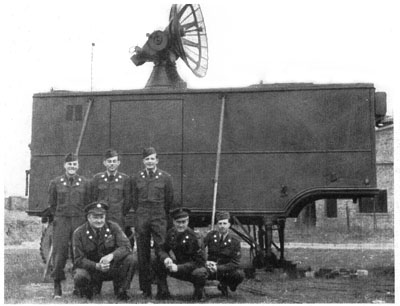
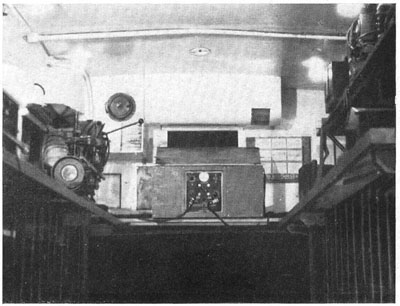 |
|
The personnel of Headquarters Battery were naturally responsible for the various functionings of administration, supply, and plans and training, while the line batteries participated in coordinated gun drill together with tracking missions and dry runs. Recruit personnel received individual basic military instruction as well as onthe-job training in all phases of antiaircraft artillery technique. Non-commissioned officers, acting as instructors and leaders of sections, were given refresher courses and have been afforded constant opportunities to keep their instruction up to date.
By July of 1949 the battalion was prepared for an actual test of its capabilities, the coordinating of its garrison training with the problems to be encountered in the field and on maneuvers. Since the summer of 1949 the 552d has engaged in firing exercises three times at Putlos and in maneuvers twice at Grafenwoehr. The trips to Putlos and Grafenwohr were combined rail and motor movements and gave the members of the battalion invaluable experience in entraining and detraining, the operation of supply lines and general conduct on convoys.
Although the emphasis has been on training, the commanding officers, Lt Col Bellamy and Lt Col George F. Pindar, who assumed command of the 552nd on 10 December 1949, have endeavored to provide for the general welfare of the men, including their education and entertainment. During the time that the battalion has been in existence, every effort has been made to provide opportunity for the troops to occupy their spare time through athletics, education courses, and such facilities as Holiday House, the Arts and Crafts room, a well-stocked Library, an Enlisted Men's Club, Post Exchange and Post Theatre. Three-day passes and furloughs to places of interest throughout Europe are constantly available. At the moment, new housing facilities are being planned along with other area improvements. |
|
|
| |
| In less than two years the 552nd Antiaircraft Artillery Gun Battalion has reached the goal for which it had aimed. It is ready for any mission which may be assigned; to those who are included in its roster, it is an organization of which they may well be proud; to others it has reached a standard of morale and achievement of which they may well be envious. |
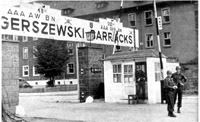 |
|
| Gerszewski Barracks, the home of the 552nd Antiaircraft Artillery Gun Battalion, is approximately 1 mile from the city limits of Karlsruhe. It is named in honor of Sergeant Adolph C. Gerszewski of the 397th Infantry Regiment, 100th Infantry Division. Sergeant Gerszewski was awarded, posthumously, the Silver Star Medal for gallantry in action on 9 April 1945 in the vicinity of Heilbronn, Germany, when he showed unusual leadership, aggressiveness and capability in reorganizing his men under cover of darkness. He personally made a reconnaissance and discovered the enemy's position and, engaging them in a fire fight, succeeded in killing five Germans, wounding three and driving the remainder from their entrenchments. |
|
|
| |
Medical Detachment
The health of the officers and men of our Battalion rests on the shoulders of the 552d AAA Gun Bn Medical Detachment, commanded by 1st Lt Earl A. Kuchera. This unit was activated in February 1949 and completed 24 weeks basic military subjects. On the 1st of June 1949, Dr. Joachim Staemmler was hired for the purpose of administering professional medical care to the ill and injured of the 552d. Only five men of the original twelve men at the time of activation still remain; however, the original medics have been replaced by men directly from the Medical Field Service School, Fort Sam Houston, Texas. At the present time four Surgical Technicians are receiving on-the-job training at the 130th Station hospital working in the operating room and in the Surgical Ward. One EM is now attending the Medical NCO School at the 11th Field Hospital in Stuttgart, and the first sergeant, Sfc Roth, graduated from the same school with honors this past August.
In addition to the continued technical training program carried out in the Medical Detachment, a daily sick call, emergency treatments and treatment appointments make up the daily routine of the Battalion Dispensary, Gerszewski Barracks. Patients are routinely evacuated to the 130th Station Hospital in Heidelberg daily for further treatment or hospitalization and medical reports forwarded through the 1st Infantry Division to higher headquarters.
These are the Medics of the 552d AAA Gun Bn upon whom your life may depend.
4th Signal Radar Maintenance Unit
Probably one of the smallest TO&E units in the Army and at present time greatly overstrength, the 4th Signal Radar Maintenance Unit is attached to the 552d in order to provide field maintenance for Radar sets of the Battalion. The unit was reorganized at the same time as the Battalion, having previously been active in the Pacific Theater during the war and also active for a short time after the war at Fort Bliss, Texas. |
|
| |
| (Source: Email from George Engle) |
|
George submitted some articles featuring Battery "D" 552nd AAA Gun Bn that won the 1st Inf Div company level softball championship in 1950.
|
|
|
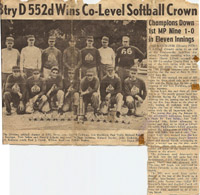
1.
|
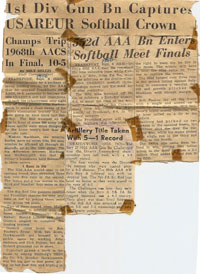
2.
|
|
|
|
|
| |
| (Source: Email from Roger Carver) |
For the heck of it, I did a search (did not expect to come up with anything) and was surprised to find your site. Great. I was assigned to the 552nd AAA Gun Battalion (The Deuce) in November 1953 and returned to the States in April 1955. My specialty -- Radio Operator (send and receive Morse code) and later Communications Chief for Baker Battery. Spent time in the Signal School in Ansbach and later, the NCO Academy in Munich.
By any chance, do you have any contacts -- any guys on the list that may have served during my time with the "Deuce"? Would like to hear from a few old buddies.
Thanks -- and a great job with site.
ADDITIONAL INFORMATION
I was assigned to the 552nd AAA Gun Battalion in November 1953, (not November 1954 as mentioned incorrectly in previous message). Colonel Spann was the Battalion Commander in those days. I was a Radio Operator in the Communications Section of Battery B (Baker Battery). Later became Communications Chief for Baker Battery Commo.
Gerszewski Barracks was located just outside the village of Knielingen, about 5 kilometers from the city of Karlsruhe. Formerly Rhein Kaserne, when occupied by the German Army. A Strassenbahn stop (street car/trolley) in the village center was our transportation into Karlsruhe for a few Pfennigs. The Strassenbahn ran from Knielingen through Karlsruhe to the opposite end of the line, a beautiful park in Durlach.
We referred to the 552nd as "The Deuce." Our mission was to defend a nearby bridge on the Rhine River from air attacks and we had monthly surprise alerts. Always a surprise, because we never knew how long we would remain on site in defensive posture, or perhaps move to another location with new orders. Happened frequently.
We had semi-annual anti-aircraft firing missions with our 90mm guns in Todendorf, near Kiel, on the Baltic Sea (about 500 miles north). Took three days to make the one-way journey by slow motor convoy.
Also, had annual field artillery firing missions in Baumholder, a mountainside range located in the French Zone.
Karlsruhe was an interesting city, with it's castle near the center of the city. Streets leading to the castle were laid out like the spokes of a bicycle, so that the castle's royal occupants could readily determine potential hostiles approaching from any angle.
Gerszewski Barracks was a small post with a PX and a post theater -- movies were 25 cents. It took six months for popular stateside movies to make it overseas for viewing.
And of course we enjoyed the local Moninger brand German beer.
Baker Battery commanding officer, Captain Mario Filocco from New York, lived off post and drove a Henry J. Lieutenant Messier was his administrative officer, second in command.
I also attended the USAREUR Signal School in Ansbach and later the 7th Army NCO Academy (Little West Point) in Munich.
Got to do some traveling -- spent a week in Garmisch, the army's R & R center in the German Alps and site of the 1936 winter olympics. Also took a 20 day leave to visit Paris, London, and Rome -- all courtesy of free military flights; worth the wait.
In those days, we crossed the Atlantic on troop ships -- took 11 days from Staten Island to Bremerhaven. Returned stateside and discharged from Camp Kilmer, April 28, 1955.
|
|
| |
| (Source: Steven and David Ray, sons of James Boyd Ray, Jr.) |
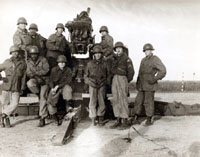 |
|
I am a American Legion Post 470 SAL (legion470.org) and would be proud to provide a photo of my father and his unit for website posting and reference.
Info on my father:
James Boyd Ray, Jr, PVT2 Crewman, 2nd Top Left. Seventh Army Artillery, 34th AAA Brigade, 12th AAA Group. 552nd Anti-Aircraft Artillery Battalion, Gun 90mm.
Stationed in Gerszewski Barracks, Karlsruhe West Germany.
Company organized on June 30th 1954.
|
|
|
|
| |
| (Source: Email from Tim Coughlin) |
I joined the 552d AAA Bn (90mm Gun) in October of 1955 at Gerszewski Barracks just outside of Karlsruhe. My Battery D was located on the 3d floor of the building on the right just inside the main gate. The winter of 1955-56 was brutal, and field exercises then were under difficult conditions as we had no modern cold weather gear (still using WWII era clothing).
The battalion was probably there much earlier as I was in the 552d AAA Bn in late 1955. We were under the 69th AAA Gp. Our task was to defend the Rhine River Bridge in the area.
In 1957 the 69th AAA Group Headquarters was near Karlsruhe at Rhineland Kaserne, Ettlingen. |
|
| |
| (Source: author's collection) |
552nd AAA AW Bn (Mbl)
Gerszewski Bks, Karlsruhe |
|
|
|
|
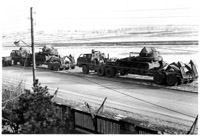
1. M26 truck-trailers |
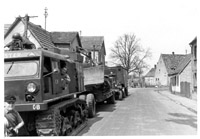
2. M4 high-speed tractor |
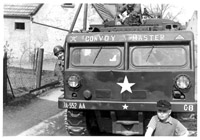
3. "Convoy Master" |
|
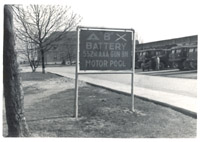
4. "B" Battery motor pool |
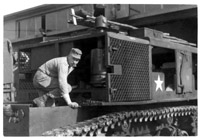
5. Pulling maintenace |
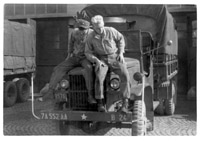
6. Busy day at the motor pool
|
|
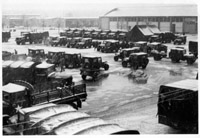
7. Motor pool |
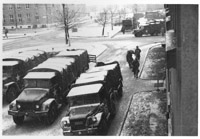
8. Getting ready for the field? |
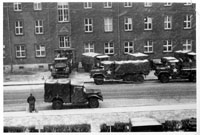
9. More preparations |
|
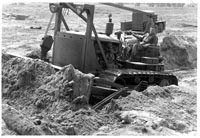
10. Bulldozer prepares position |
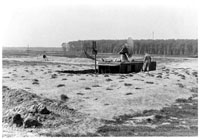
11. Acquisition radar |
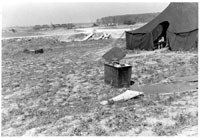
12. In the field |
|
|
 |
|
| |
| 505th AAA Operations Detachment |
| |
| 1953 |
| (Source: STARS & STRIPES, May 11, 1953) |
The 505th AAA Opns Det, stationed in Karlsruhe, is attached to the 12th AAA Group and is responsible for operating an antiaircraft operations control center that helps oversee the overall operations of the group's subordinate AAA batallions. The operations center receives (surveillance) radar information on air activity over its sector and tracks aircraft on a large plotting table (see a nice example of such an operation as shown in a photo on the 32nd AAA Brigade Bushey Hall website). Information on distant airplanes comes to the center from various (USAF) sources, while data on local aircraft is obtained from units in the immediate area.
The plotting table is covered by a large map on which the plotters mark the course of the aircraft and provides the Group defense commander and the operations officer with a graphic display of all airplanes in the group's sector.
The chief plotter, an SFC, is in charge of the floor, supervising the plotters as well as keeping up to date the various "status boards" that provide the latest information on defense units. |
|
| |
| 1957 |
| (Source: STARS & STRIPES, Sept 12, 1957) |
| The 505th AAA Det of 12th AAA Gp was inactivated in September 1957. |
 |
|
| |
Related Links:
|
| |
| |
| |
|
 73rd AAA AW Bn (SP) DUI
73rd AAA AW Bn (SP) DUI 91st AAA Gun Bn DUI
91st AAA Gun Bn DUI
 552nd AAA Gun Bn DUI
552nd AAA Gun Bn DUI